Begonia Luxurians, often referred to as the “Palm-Leaf Begonia” is a captivating and exotic plant that belongs to the Begonia genus. This striking foliage plant is native to the cloud forests of the Andes in South America, and it has gained popularity among plant enthusiasts for its unique appearance and relatively easy care requirements.
Begonia Luxurians Overview
Before delving into care tips and other details, let’s take a closer look at what makes Begonia Luxurians so special:
- Foliage: The most distinguishing feature of Begonia Luxurians is its lush and palm-like leaves. The foliage is characterized by multiple small leaflets attached to a central stem, resembling a miniature palm tree. The leaves can reach up to 12 inches in length, creating a lush and tropical feel in your home or garden.
- Coloration: The leaves of Begonia Luxurians typically have a vibrant green hue with reddish veins, adding to their visual appeal. The vibrant coloration makes this begonia a standout choice for indoor or shaded outdoor spaces.
- Growth Habit: This begonia can grow upright, reaching heights of up to 3 feet or more in its natural habitat. When grown in pots or containers, it may not reach such heights, making it a suitable choice for indoor and patio gardens.
- Flowering: While Begonia Luxurians is primarily grown for its foliage, it may also produce small and inconspicuous white flowers. These flowers appear on the plant, adding a subtle touch of elegance to the overall appearance.
Genus Species

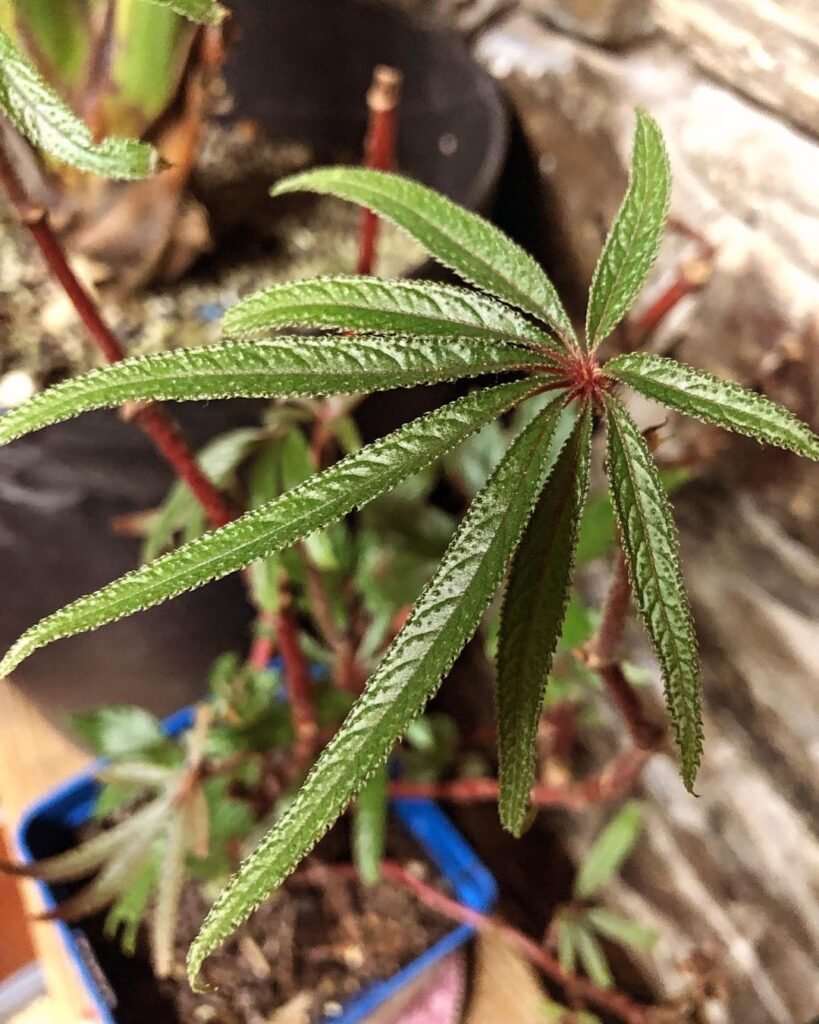
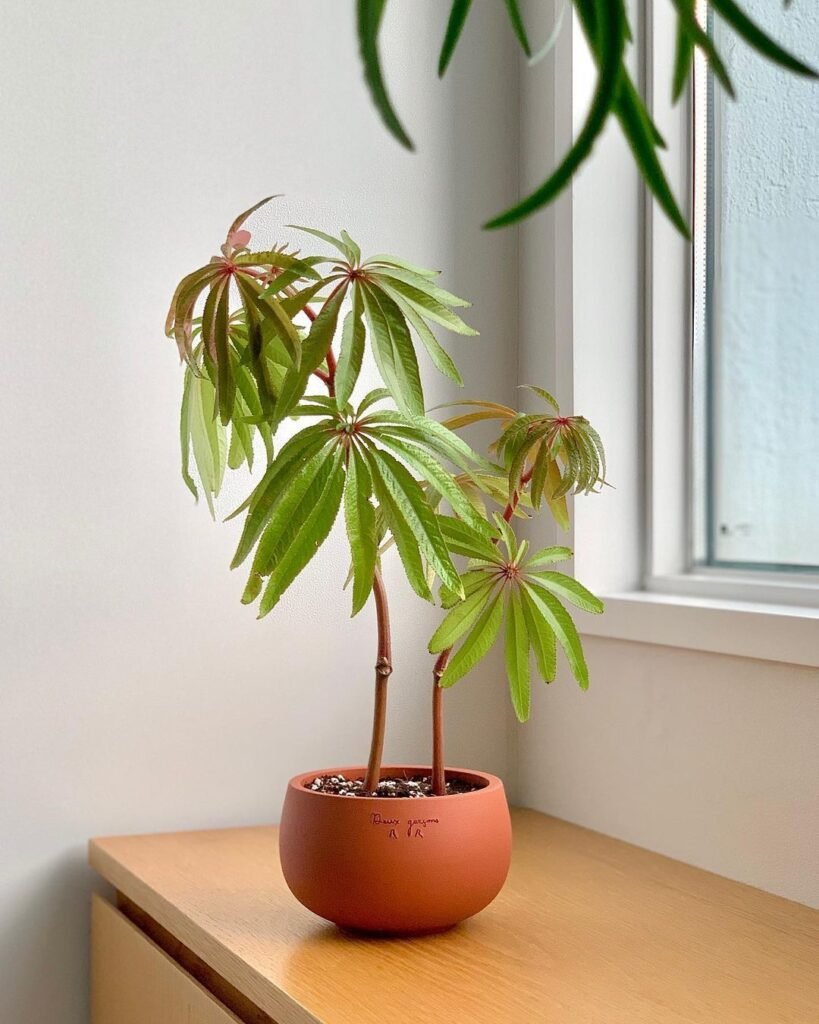
Understanding the botanical classification of Begonia Luxurians is essential for those looking to cultivate and care for this plant effectively.
Taxonomy of Begonia Luxurians
Begonia Luxurians falls under the following taxonomic categories:
- Genus: Begonia
- Species: Luxurians
- Family: Begoniaceae
This elegant begonia is part of the Begonia genus, known for its vast diversity in species and varieties. The Begoniaceae family encompasses all Begonia species, making it a fascinating and popular choice for horticulturists and collectors.
Begonia Genus Insights
To gain a deeper understanding of Begonia Luxurians, let’s briefly explore its genus, Begonia:
- Diversity: The Begonia genus is renowned for its rich diversity, comprising over 1,800 species, including both ornamental and horticultural varieties. This diversity offers a wide range of options for indoor and outdoor gardening.
- Cultural Significance: Begonias are not only cherished for their ornamental value but also hold cultural significance in various regions. For instance, in some cultures, begonias symbolize gratitude and respect, making them a thoughtful gift choice.
- Versatility: The genus encompasses an array of plant types, from perennial herbaceous species to woody shrubs. Each species offers its unique charm and care requirements, and Begonia Luxurians is no exception.
- Hybrid Varieties: The world of begonias is further enriched by the creation of hybrid varieties, including those with unique foliage patterns and vibrant flower colors. Hybrids like Begonia Luxurians have contributed to the popularity of this genus among gardeners and collectors.
Begonia Luxurians Appearance


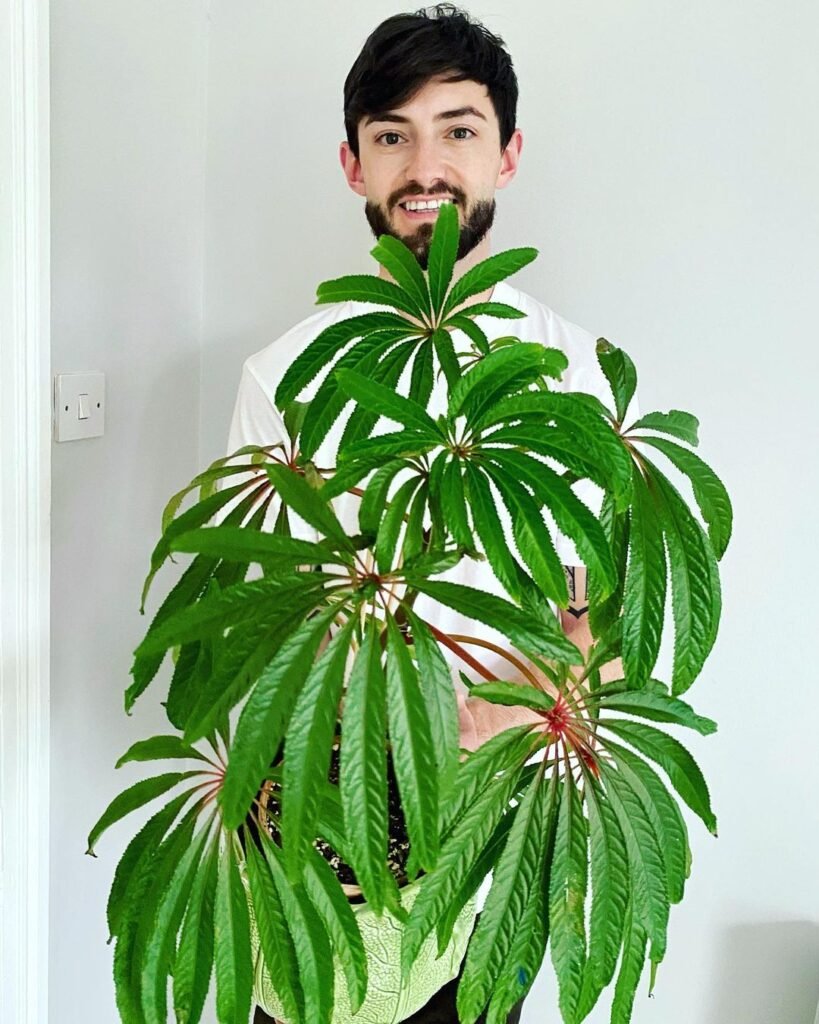
The allure of Begonia Luxurians lies in its striking foliage. Let’s explore its appearance in more detail and discover what sets it apart from other houseplants.
Foliage Structure
The most prominent feature of Begonia Luxurians is its foliage, which resembles the fronds of a palm tree. The leaves are palmately compound, consisting of numerous leaflets attached to a central stem. These leaflets are typically deep green with vibrant red veins, creating an eye-catching contrast.
Size and Growth Habit
Begonia Luxurians has the potential to grow quite tall, especially when planted in optimal conditions. In its native habitat, it can reach heights of up to three feet or more. However, when cultivated in pots or containers, its growth may be more restrained, making it suitable for indoor gardening. The leaves themselves can reach up to 12 inches in length, adding to the plant’s lush appearance.
Coloration
The vivid green color of Begonia Luxurians’ leaves provides a refreshing and tropical feel to any space. The red veins running through the leaves accentuate their visual appeal. This combination of colors is what makes this begonia a striking addition to gardens, indoor spaces, or shaded patios.
Flowers
While Begonia Luxurians is primarily grown for its foliage, it may also produce small white flowers. These blossoms, while not the primary focus of the plant, add a delicate touch to the overall aesthetic. The majority of begonia enthusiasts, however, are captivated by the lush foliage rather than the blooms.
Not the plant for you? Check out my full list of 78 Types of Begonia!
Begonia Luxurians Care Tips
When it comes to caring for Begonia Luxurians, it’s important to understand its specific requirements to ensure it thrives. Below, you’ll find a quick overview along with a table of some interesting care tips and tricks:
| Aspect of Care | Tips and Tricks |
|---|---|
| Light Requirements | – Place in bright, indirect sunlight. |
| – Protect from harsh midday sun. | |
| Soil Conditions | – Use well-draining, peat-based soil. |
| – Keep the soil consistently moist but not soggy. | |
| Temperature & Humidity | – Maintain temperatures between 65-75°F (18-24°C). |
| – Provide higher humidity levels, if possible. | |
| Watering Guidelines | – Water when the top inch of soil is dry. |
| – Avoid overwatering; root rot is a common issue. | |
| Fertilization | – Feed with a balanced liquid fertilizer during the growing season. |
| – Reduce fertilization in the winter months. |
Begonia Luxurians Light and Soil Requirements
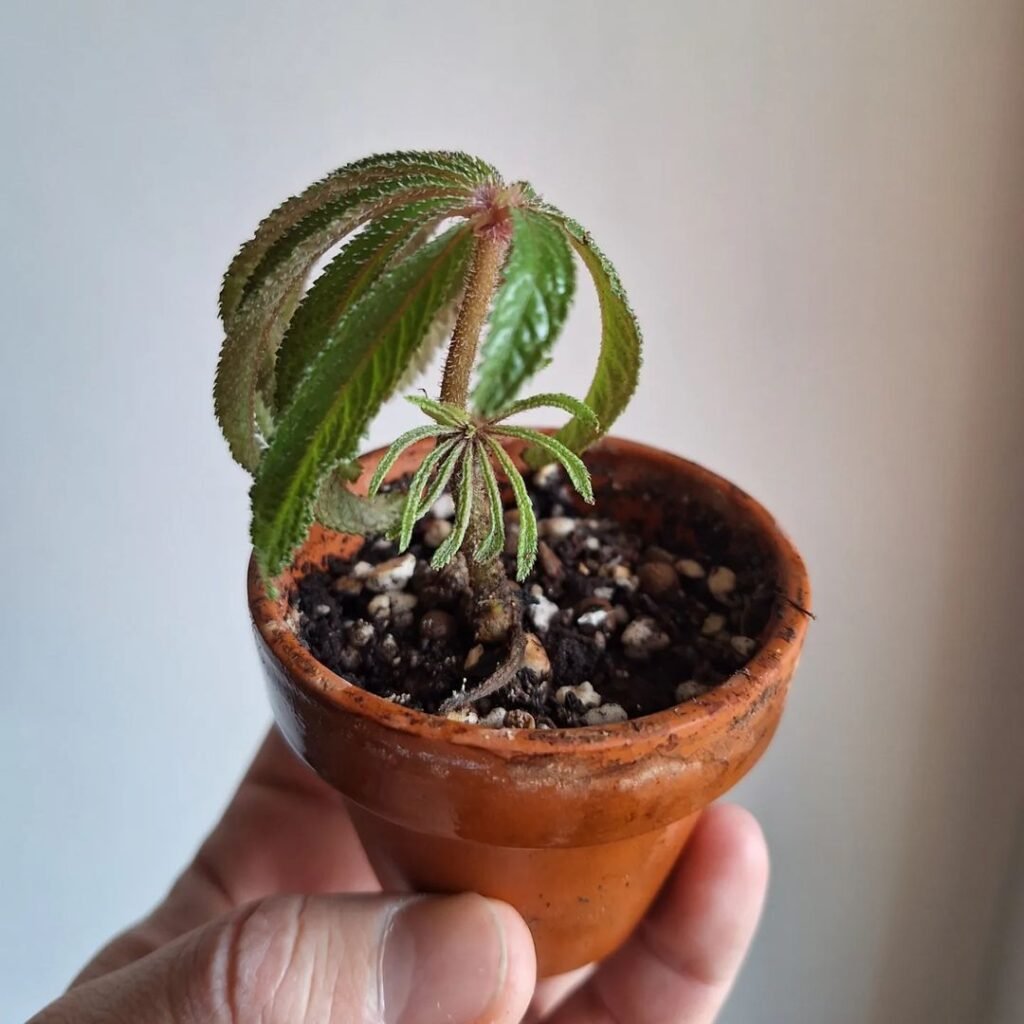

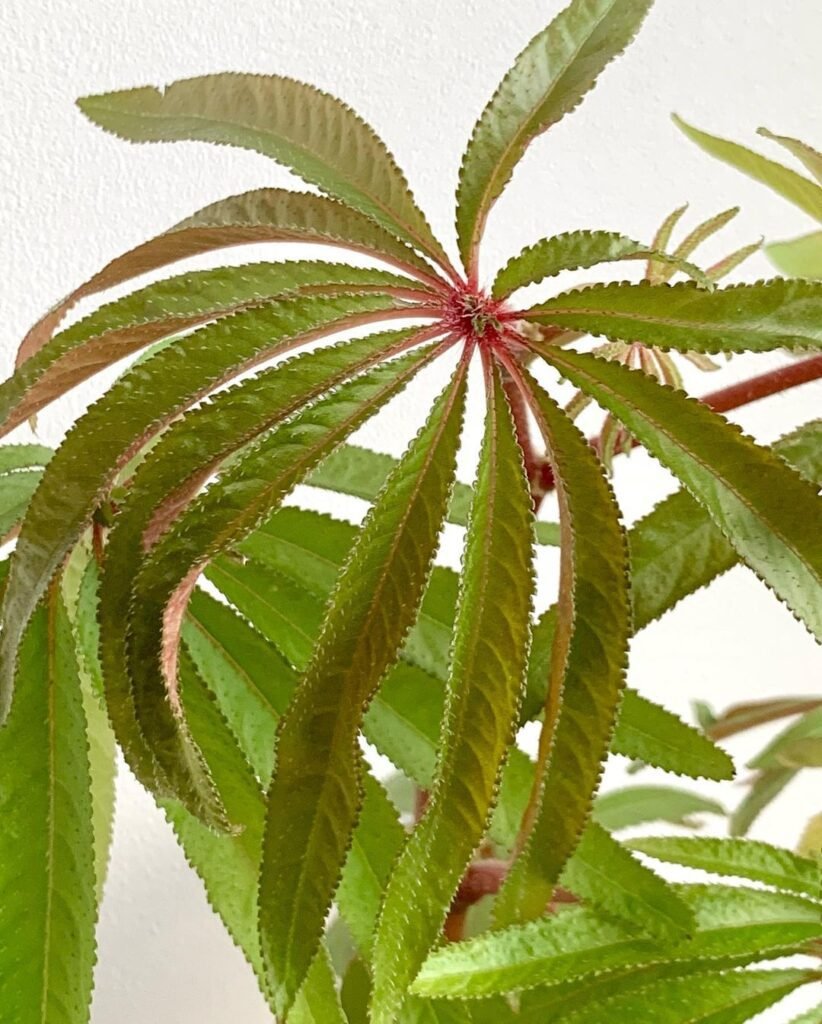
Light Requirements
Begonia Luxurians thrives in bright, indirect sunlight. This means placing your plant near a window where it receives plenty of light but is shielded from direct sun exposure. In its native habitat, it grows beneath the canopy of tall trees, making it adapted to filtered light. Ensure that your plant is not exposed to harsh midday sun, as this can scorch the leaves.
Soil Conditions
The right soil mix is crucial for the well-being of your Begonia Luxurians. Opt for a well-draining potting mix that is rich in peat. This ensures proper aeration and moisture retention without leading to waterlogged roots. Make sure the soil remains consistently moist but not waterlogged to prevent root rot.
Watering Begonia Luxurians
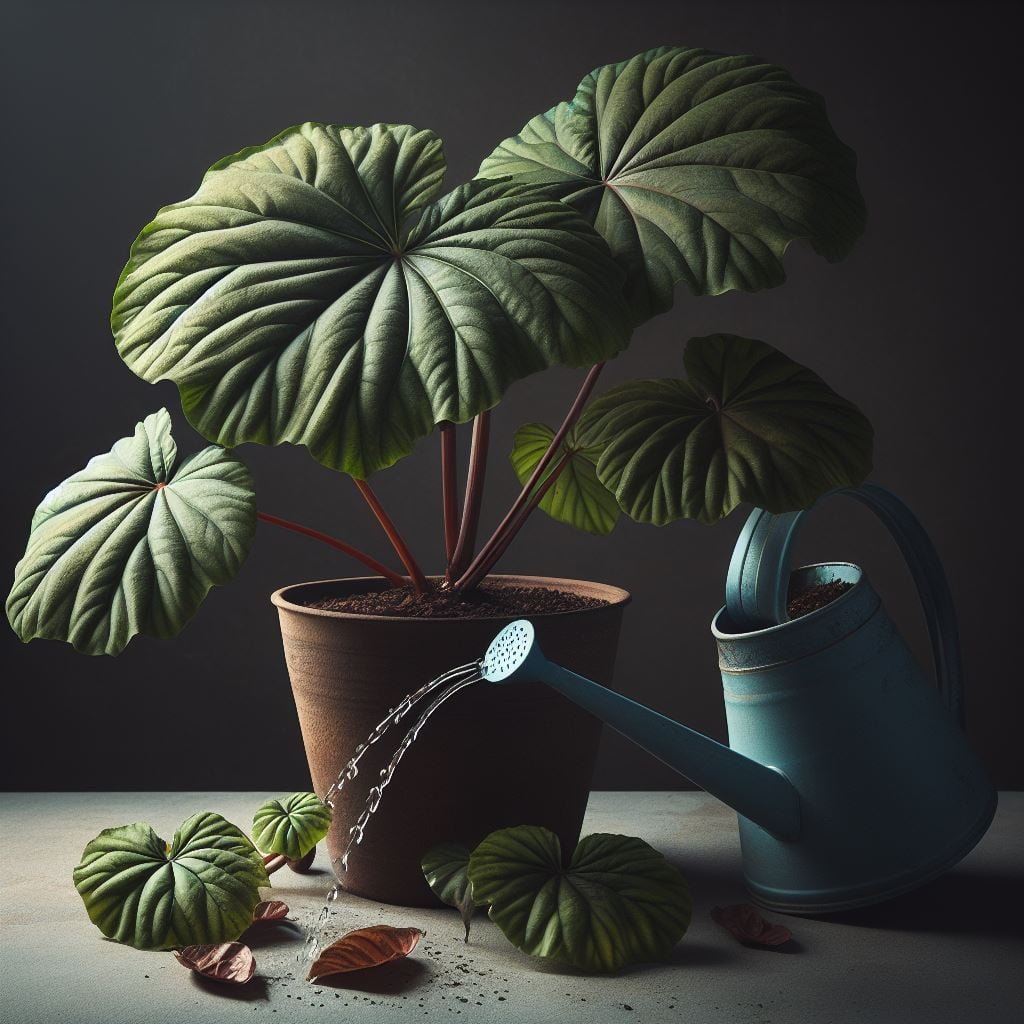
Proper watering is a key component of Begonia Luxurians care. The goal is to maintain a balance between keeping the soil moist and avoiding overwatering. Here are some guidelines to follow:
- Water your Begonia Luxurians when the top inch of soil feels dry to the touch. This means you should allow the soil to partially dry out between waterings.
- Use a saucer under the pot to catch excess water, preventing the plant from sitting in standing water, which can lead to root issues.
- Overwatering is a common problem with begonias, so be cautious not to saturate the soil.
Begonia Luxurians Humidity and Temperature
Temperature Requirements
Begonia Luxurians prefers a moderate temperature range. Keep your indoor environment at a consistent temperature between 65-75°F (18-24°C). Avoid exposing the plant to temperature extremes, which can lead to stress and damage.
Humidity Considerations
Humidity is another crucial aspect of care for Begonia Luxurians. In its natural habitat, it enjoys high humidity levels due to its cloud forest origins. To mimic these conditions, consider the following:
- Use a humidity tray or room humidifier to maintain higher humidity levels, especially in dry climates.
- Regularly mist the plant to create a more humid microenvironment around it.
- Avoid placing your Begonia Luxurians near drafts or heating vents, as these can reduce humidity and temperature stability.
By paying close attention to these temperature and humidity guidelines, you can create a more comfortable and conducive environment for your Begonia Luxurians to thrive.
Fertilizing Begonia Luxurians

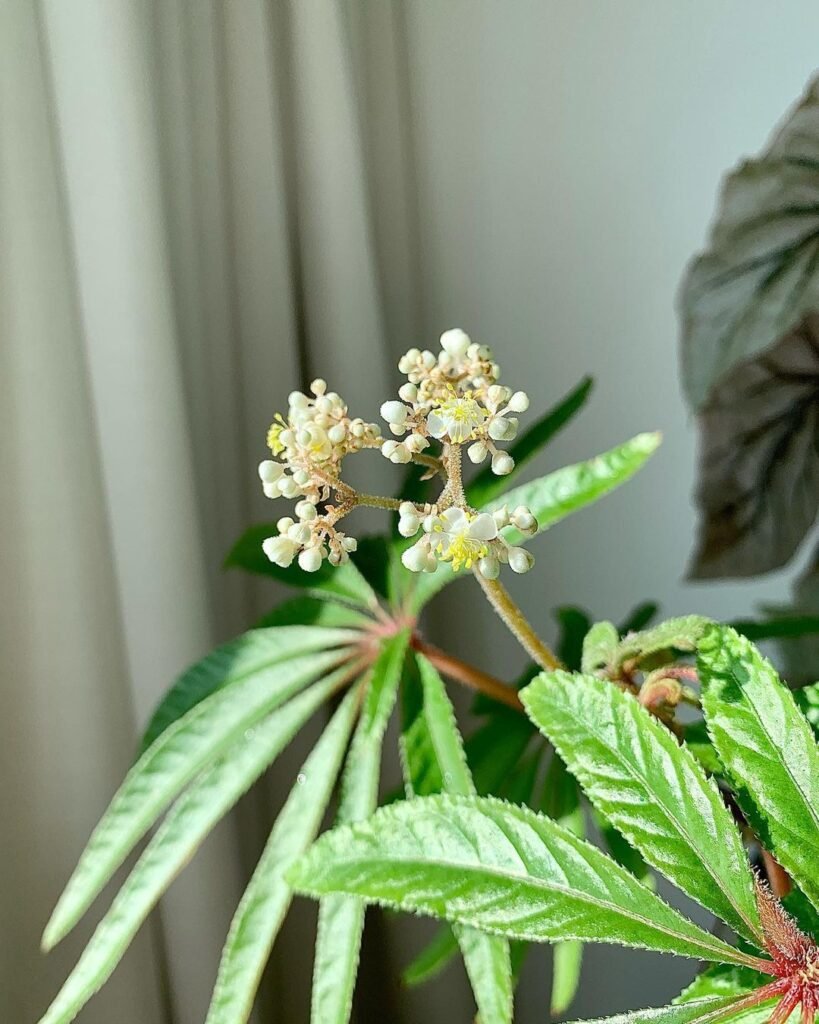
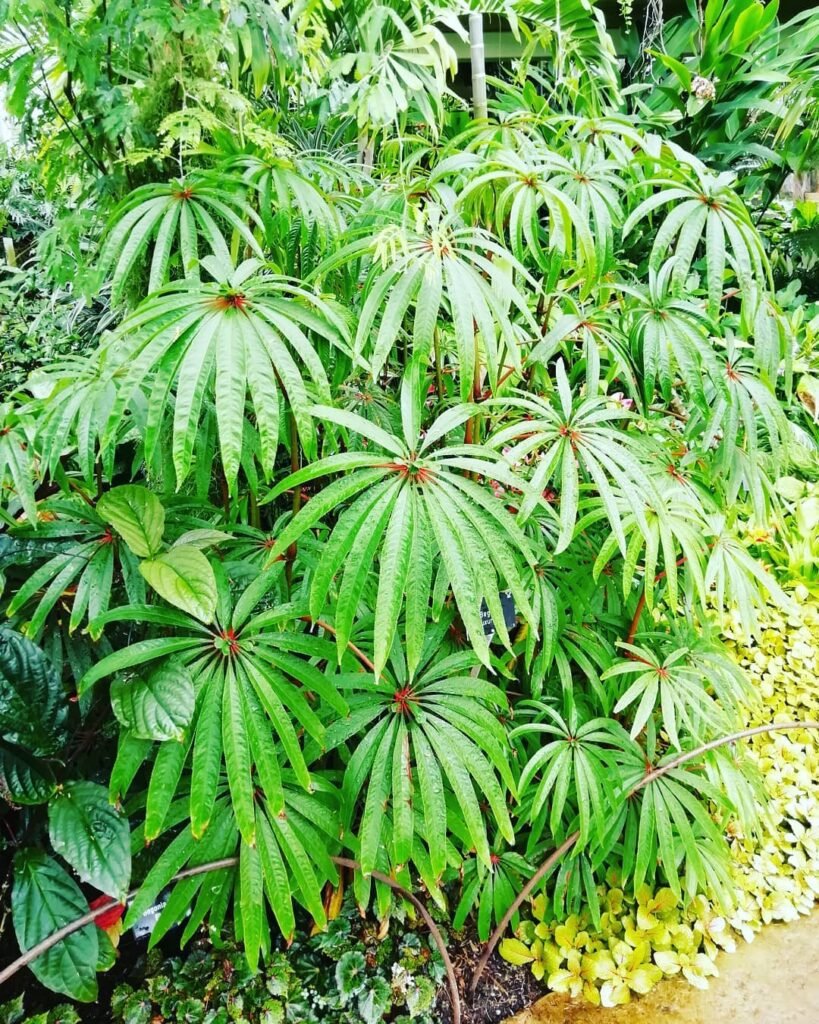
Fertilization is a crucial aspect of Begonia Luxurians care. Proper feeding ensures that your plant remains healthy, vibrant, and capable of producing its stunning foliage. Here’s how to effectively fertilize your Begonia Luxurians:
Feeding Schedule
- During the growing season, which typically spans from spring to early autumn, feed your Begonia Luxurians every 4-6 weeks. This is when the plant is actively producing new growth and requires additional nutrients.
Fertilizer Type
- Opt for a balanced, water-soluble fertilizer with equal N-P-K (Nitrogen, Phosphorus, Potassium) ratios, such as 10-10-10 or 20-20-20.
- Dilute the fertilizer to half the recommended strength to avoid over-fertilization, which can harm the plant.
Application Method
- Water your Begonia Luxurians thoroughly before applying fertilizer to prevent root burn.
- Apply the diluted fertilizer solution to the soil, avoiding contact with the leaves.
- Ensure that the soil is moist when you apply the fertilizer, as this helps distribute nutrients more evenly.
Winter Fertilization
- In the winter months, reduce or entirely stop fertilization as the plant’s growth slows down. Over-fertilizing during this period can stress the plant.
Begonia Luxurians Pruning and Shaping
Pruning and shaping your Begonia Luxurians are essential for maintaining its size and appearance. Here are some tips on how to go about it:
Pruning
- Regularly prune your Begonia Luxurians to remove dead or damaged leaves and encourage new growth.
- Use clean, sharp scissors or pruning shears to make precise cuts, minimizing stress to the plant.
- If the plant becomes too tall or leggy, prune it back to your desired height, keeping in mind that it may encourage bushier growth.
Shaping
- Begonia Luxurians has a natural upright growth habit. To maintain its shape, pinch or cut back the top growth periodically.
- This encourages lateral branching, creating a fuller and more compact appearance.
- Use the pruned cuttings for propagation if you wish to expand your Begonia Luxurians collection.
Begonia Luxurians Propagation and Repotting

Propagation allows you to share the beauty of your Begonia Luxurians or create new plants for your collection. Repotting is necessary to provide the plant with fresh soil and more space as it grows.
Propagation
Leaf Cuttings
- One of the most common methods of propagating Begonia Luxurians is through leaf cuttings.
- Select a healthy leaf and cut it into sections, making sure each section has a vein or vein-like structure on it.
- Plant the sections in a moist, well-draining propagation medium.
- Provide indirect light and maintain high humidity until new growth emerges.
Division
- If your Begonia Luxurians has multiple stems, you can divide it when repotting.
- Gently remove the plant from its pot, separate the stems, and plant them in individual containers with fresh potting mix.
Repotting
- Begonia Luxurians generally needs repotting every 2-3 years or when it outgrows its current container.
- Choose a slightly larger pot with good drainage to provide room for the plant’s roots to grow.
- Refresh the potting mix to ensure it remains well-draining and nutrient-rich.
By mastering these techniques for fertilization, pruning, and propagation, you can keep your Begonia Luxurians thriving and enjoy its beauty for years to come.
Begonia Luxurians Seasonal Care
Understanding the seasonal needs of your Begonia Luxurians is essential for its overall health and well-being. Different seasons come with varying requirements, so let’s explore how to care for your plant throughout the year:
Spring Care
- In spring, your Begonia Luxurians will begin its active growing season. This is the time to start fertilizing and resume regular watering.
- Inspect your plant for any signs of pests or diseases, which tend to become more active in the warmer months.
- If your plant has outgrown its pot, consider repotting it to provide more space for new growth.
Summer Care
- During the summer, ensure that your Begonia Luxurians is protected from direct sunlight, which can scorch its delicate leaves.
- Keep a close eye on soil moisture; the warmer weather may require more frequent watering.
- Maintain humidity levels by misting the plant or using a humidity tray, as hot, dry conditions can stress the plant.
Fall Care
- As temperatures begin to drop in the fall, reduce the frequency of fertilization as your plant’s growth slows down.
- Continue to provide bright, indirect light, as Begonia Luxurians may not appreciate dim conditions.
- Watch for signs of overwatering, as the plant’s water needs may decrease with cooler weather.
Winter Care
- In winter, it’s essential to protect your Begonia Luxurians from cold drafts and maintain a stable indoor temperature between 65-75°F (18-24°C).
- Reduce watering to prevent root rot and only fertilize sparingly, if at all.
- Monitor the plant for signs of pests, which can be more problematic during the winter when indoor environments are drier.
Adapting your care routine to the changing seasons ensures your Begonia Luxurians remains healthy and happy throughout the year.
Begonia Luxurians Companion Plants
Selecting suitable companion plants to grow alongside your Begonia Luxurians can enhance the visual appeal of your garden or indoor space. Here are some excellent choices to consider:
1. Ferns
- Ferns are a natural companion for Begonia Luxurians due to their similar preference for indirect light and high humidity.
- The lush, feathery fronds of ferns complement the palm-like foliage of Begonia Luxurians.
2. Calathea Species
- Calathea plants, known for their striking leaf patterns, share the same preferences for humidity and indirect light.
- The combination of patterns and textures creates a visually appealing display.
3. Peperomia
- Peperomia species are easy-going houseplants that work well with Begonia Luxurians in indoor arrangements.
- Their compact size and varied leaf shapes add interest to your plant collection.
4. Orchids
- Orchids appreciate the same temperature and humidity conditions as Begonia Luxurians.
- Their elegant blooms provide a delightful contrast to the begonia’s lush foliage.
5. Maidenhair Fern
- Maidenhair ferns are known for their delicate, airy appearance and complement the exotic look of Begonia Luxurians.
- Both plants thrive in the same care conditions, making them compatible companions.
When selecting companion plants, ensure they share similar care requirements, especially in terms of light, humidity, and temperature. This harmonious combination will create a visually stunning and thriving plant arrangement.
If you’re thinking of extending your begonia plant family, read up on begonia darthvaderiana care and begonia semperflorens care to help you decide on the next addition to your squad.
Pest Control Tips for Begonia Luxurians
Despite your best efforts, pests may occasionally target your Begonia Luxurians. It’s important to recognize and address pest issues promptly. Here are some common pests and tips on how to control them:
| Pest | Symptoms | Control Tips |
|---|---|---|
| Aphids | – Visible tiny, soft-bodied insects on leaves. | – Use a strong stream of water to dislodge aphids. |
| – Sticky honeydew secretion on leaves. | – Apply neem oil or insecticidal soap to affected areas. | |
| Mealybugs | – White, cottony masses on the plant. | – Remove mealybugs with a soft brush or cotton swab. |
| – Weakened, yellowing foliage. | – Treat with insecticidal soap or neem oil. | |
| Spider Mites | – Fine webbing on leaves. | – Rinse leaves with water to remove mites and webbing. |
| – Leaves may appear speckled and discolored. | – Use neem oil or horticultural oil to control mites. |
Regularly inspect your Begonia Luxurians for signs of pest infestations and take action as soon as you notice any issues. Early intervention is key to keeping your plant healthy and pest-free.
Reviving a Sick or Wilting Begonia Luxurians
Sometimes, despite your best efforts, your Begonia Luxurians may show signs of distress. Here are some steps to help you revive a sick or wilting plant:
1. Assess the Issue
- Examine your plant carefully to identify the problem. Look for symptoms such as yellowing leaves, wilting, or discoloration.
2. Adjust Watering
- If the soil is waterlogged or the roots appear mushy, reduce watering immediately to prevent further damage.
- Conversely, if the soil is too dry, increase your watering frequency.
3. Pruning
- Trim away any dead or yellowing leaves, as they won’t recover and can stress the plant.
- Remove any pests if present, as they may be contributing to the problem.
4. Repotting
- If root rot is suspected, carefully remove the plant from its pot, trim away affected roots, and repot it in fresh, well-draining soil.
- Consider adjusting the pot size if it’s too small or too large for the root system.
5. Adjust Environmental Conditions
- Ensure the plant is receiving the right amount of indirect light, appropriate humidity, and consistent temperatures.
6. Be Patient
- Reviving a wilting Begonia Luxurians may take time. Continue to provide proper care and monitor the plant’s progress.
Conclusion
In conclusion, Begonia Luxurians, also known as the Palm-Leaf Begonia, is a captivating and unique plant that can thrive in your indoor or outdoor garden. By understanding its specific care requirements, you can enjoy its lush foliage and exotic appearance for years to come. Remember to provide:
- Proper Light: Bright, indirect sunlight is key to its growth.
- Well-Draining Soil: Ensure good aeration and moisture control with the right soil mix.
- Careful Watering: Keep the soil consistently moist, avoiding overwatering.
- Optimal Temperature and Humidity: Maintain stable conditions to mimic its natural habitat.
- Fertilization: Feed it during the growing season to promote lush growth.
- Pruning and Shaping: Maintain its shape and size through pruning.
- Propagation: Create new plants or share the beauty with others.
- Seasonal Care: Adapt care routines to the changing seasons.
- Companion Plants: Pair it with suitable companions for a visually appealing garden.
- Pest Control: Address and prevent common pests promptly.
- Reviving Tips: Restore ailing plants with the right care adjustments.
With the right care and attention, your Begonia Luxurians can become a stunning centerpiece in your plant collection.
FAQs
How often should I water my Begonia Luxurians?
The frequency of watering depends on factors like temperature, humidity, and pot size. Water when the top inch of soil is dry, typically every 1-2 weeks.
Can Begonia Luxurians tolerate direct sunlight?
No, it prefers bright, indirect sunlight. Direct sun can scorch its delicate leaves.
What are some common pests that affect Begonia Luxurians?
Common pests include aphids, mealybugs, and spider mites. Regular inspection and early intervention are essential for pest control.
When should I repot my Begonia Luxurians?
Repot when the plant outgrows its current container or every 2-3 years. Ensure the new pot has good drainage and fresh soil mix.
What’s the ideal humidity level for Begonia Luxurians?
It thrives in higher humidity, so aim for levels between 50-60% if possible. Using a humidity tray or room humidifier can help maintain these conditions.

Writer/Green Thumb/Explorer – Rooted deep in the rich soils of Devon, I’ve cultivated a vast expertise in plant care, helping greenery thrive in homes across the UK. When I’m not crafting detailed plant care guides, I’m journeying through the lush landscapes of the West Country, unearthing nature’s secrets and sharing them with fellow plant enthusiasts. Every leaf has a story, and I’m here to tell it.





